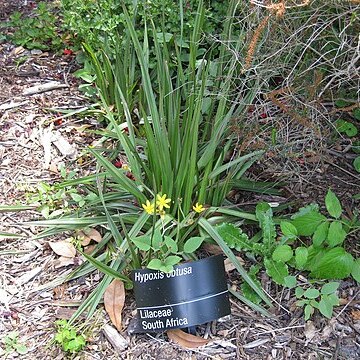Perennial herb, 200-450 mm high; robust, growing singly. Rhizome subglobose, oblong or turbinate, 4-12 x 4-8 mm. Leaves 8-15, well developed at flowering, coriaceous, erect or recurving, arranged one above the other in 3 ranks, rigid, spirally twisting towards apex with age, waxy; blade lanceolate, sometimes linear-lanceolate, 100-700 x 6-30 mm; ribbed, bases sometimes red or purple; almost glabrous or hairy towards base, margins and midrib outlined in white by a thickened band of squat hairs (ciliate); hairs stellate. Flowers: 5-12-flowered, racemose, 2-5 per plant; perianth segments 10-20 x 6-10 mm, ovate-elliptic, yellow; Aug.-Feb. Fruit a capsule, 6-7 x 5-7 mm, opening by a circular slit.
Outer tepals (7)11–18(22) × 4–7.5 mm, lanceolate, ± involute on the margins, somewhat coriaceous, ± densely greyish-white strigose-sericeous to tawny hispid outside; the inner 10–14 × 6–10 mm, broadly elliptic to ovate, ± involute on the margins, membranous, glabrous, or the abaxial midrib strigose-sericeous; the indumentum hairs 3–6-armed (stellate) with one arm strongly developed, ascending and up to c. 5 mm long.
Scapes up to c. 30 cm long, flattened in cross-section and up to 5 mm wide, ± densely white strigose particularly towards the apex and on the margins towards the base, the hairs unequally 3–6-armed (stellate) with 1–2 strongly developed arms directed to the apex and 1–2(4) arms directed to the base.
Perennial geophyte, similar to H. hemerocallidea. Leaves stiff and strongly ribbed, due to the many veins (30-70) close to each other, thickened and raised on upper surface, blade waxy, nearly hairless, margins and midrib outlined in white by a thickened band of squat hairs. Flowering time Aug.-Feb.
Flowers 2–13, erect-ascending, in a raceme-like ± cylindrical arrangement 3–13 cm long; bracts 7–25(30) mm long, subulate to linear-lanceolate; pedicels ascending, the lower ones 5–20 mm long, the upper decreasing in length.
A herb that keeps growing from year to year. It grows 16-50 cm tall. It has a stout rhizome or underground stem. The leaves are stiff and become twisted with age. There are white hairs along the edges.
Seeds black and glossy, 1.3–2 × 1–1.5 mm, ovoid; testa smooth or ± covered in closely-spaced incipient dome-shaped undulations, the cuticle smooth.
Rhizome stout, vertical 4–7 × 3.5–6 cm, turbinate to ± cylindrical, equatorially ringed by stout contractile roots.
Inflorescences 1–4, usually overtopping the arcuate leaves, appearing before the leaves.
Capsule 5–7 mm long and 5–7 mm in diameter, turbinate, circumscissile.
Filaments 2–5 mm long, narrowly triangular; thecae 5–8 mm long.
Style 1–2 mm long; stigma c. 3 mm long.
Perennial herb 16–50 cm tall.

